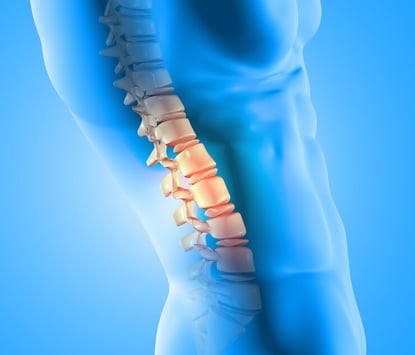The Spine: The Backbone of the Human Body
The human spine is called the "backbone" for good reason: it's not just your body's central support structure, but also a marvel of nature that balances strength, flexibility, and function. Imagine life without it! Standing, sitting, or even simple movements would be impossible. The spine isn't just a collection of bones; it's a delicate system designed to protect your spinal cord, bear your body's weight, and give you the flexibility to bend, twist, and turn.
MEN & WOMEN
11/28/2024
Anatomy of the Spine
At first glance, the spine may appear to be just a simple column of bones. But upon closer inspection, you'll discover a complex structure that combines strength and flexibility. Here's how it's structured:
Vertebrae
The spine is made up of 33 small bones called vertebrae. These bones stack on top of each other like building blocks. The vertebrae are divided into five regions:
Cervical (neck) vertebrae: The top seven vertebrae support the head and allow it to bend and rotate.
Thoracic (mid-back) vertebrae: The next twelve vertebrae stabilize the ribs and protect the heart and lungs.
Lumbar (lower back) vertebrae: The five lumbar vertebrae bear most of the body's weight, making them strong and sturdy.
Sacrum: These five fused bones connect the spine to the pelvis.
Coccyx (tailbone): The lower part of the spine, helping with balance when sitting.
Discs
Between each vertebra are gelatinous cushions called intervertebral discs. These discs act as shock absorbers, allowing the spine to withstand daily wear and tear. They also help the spine maintain its flexibility, allowing you to bend and twist with ease.
Spinal Cord and Nerves
The spinal cord runs through the spine and serves as a pathway for nerves that send messages between the brain and the rest of the body. It is safely tucked away in the spinal canal, protected by the vertebrae.
Muscles and Ligaments
The spine doesn't work alone! The surrounding muscles and ligaments provide support, stability, and movement. Think of them as a hardworking spinal team.
Functions of the Spine
The spine performs multiple functions, including:
Support: The spine is the main structure that supports the head, chest, and upper body.
Protection: The spine protects the spinal cord from injury and is essential for bodily functions such as movement, sensation, and reflexes.
Mobility: Thanks to its unique structure, the spine allows for twisting, bending, and movement in all directions.
Shock absorption: The intervertebral discs cushion the impact of movements such as walking, running, and jumping.
Posture: A healthy spine helps maintain body alignment and balance, preventing problems such as back pain and fatigue.
Common Spine Problems
Despite its unique design, the spine is susceptible to injury and wear and tear over time. Here are some common problems people face:
Back Pain
Back pain is perhaps the most common complaint, and it can range from mild discomfort to chronic pain. Poor posture, muscle strain, or prolonged sitting can contribute to it.
Herniated Disc
When the inner gelatinous layer of an intervertebral disc pushes through its tougher outer layer, it can press on nerves, causing pain, numbness, or weakness. This condition is often referred to as a "slipped disc" or "bulging disc."
Scoliosis is a sideways curvature of the spine. While mild cases may not cause problems, severe cases can lead to pain and limited mobility.
Osteoporosis
This condition weakens bones, making them more susceptible to fractures. The spine is often one of the first areas affected.
Sciatica
Sciatica occurs when the sciatic nerve is compressed, often due to a herniated disc. This can cause pain, tingling, or numbness that radiates down the leg.
Spinal Stenosis
As you age, the spinal canal can narrow, compressing the spinal cord and nerves. This can lead to pain, numbness, or difficulty walking.
How to Maintain a Healthy Spine
A healthy spine is essential to your overall health. Here are some simple and effective tips for maintaining a strong, pain-free spine:
Practice Good Posture
Always sit and stand with your back straight and your shoulders relaxed. Avoid slouching, as this puts unnecessary pressure on your spine.
Stay Active
Exercise strengthens the muscles that support your spine. Activities like swimming, yoga, and walking are particularly beneficial for your back.
Lift Properly
When lifting heavy objects, bend your knees and keep your back straight. Avoid twisting while lifting.
Maintain a Healthy Weight
Excess weight, especially around the abdomen, puts additional pressure on your lower back.
Sleep Well
Use a mattress that provides adequate support and sleep in a position that keeps your spine aligned. A pillow under your knees can help reduce pressure on your lower back if you sleep on your back.
Stretch regularly
Stretching improves flexibility and reduces the risk of injury. Focus on stretching exercises that target your back and hamstrings.
Quit smoking
Smoking reduces blood flow to the spine and may accelerate degeneration of the spinal discs.
Consult a specialist
Don't ignore chronic back pain. A physical therapist, chiropractor, or physician can help you treat problems before they worsen.
Fun Facts About the Spine
The spine contains 120 muscles, 220 ligaments, and 100 joints, all working together to support and move the body.
At birth, the human spine consists of 33 vertebrae, but as we age, some fuse, leaving us with 24 mobile vertebrae.
The spinal cord stops growing around age five, although the spine continues to grow.
The smallest vertebrae are located in the cervical spine, while the lumbar vertebrae are the largest and support the body's weight.
Your spine is the foundation of your work, supporting you in ways you may not realize. It's easy to ignore it until something goes wrong. But with a little care and attention, you can keep your spine healthy and functional for years to come.
Remember, every time you sit up straight or walk, you're investing in the health of your spine. Take good care of it—it's truly the backbone of your life!


Follow us on social media
Explore fitness articles and personal training options.
Fitness Jobs
© 2024. All rights reserved.
